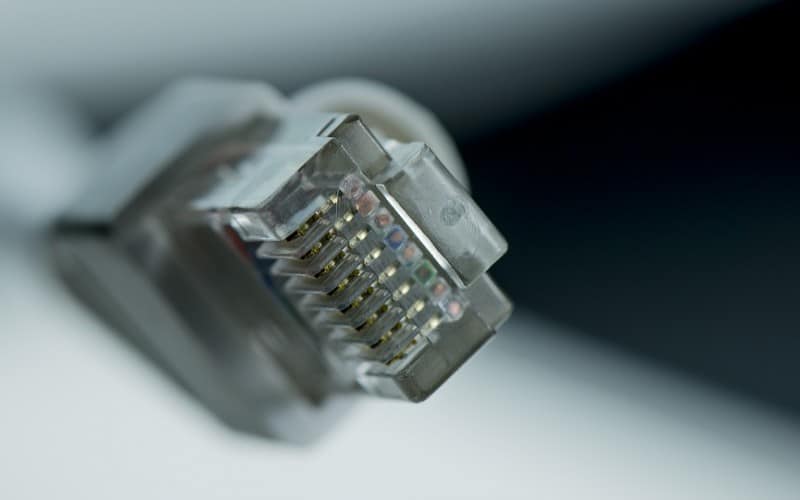Is LAN Safer than Wi-Fi?

LAN (Ethernet) is generally considered safer than Wi-Fi due to its physical access requirements, stronger built-in security measures, and limited signal reach. However, both LAN and Wi-Fi networks can be secure if proper security measures are implemented. Check our comparison tables for details.
It is continually difficult to decide on one kind of connection or another for our house, but, you must not get over excited among the multiple choices that are accessible to you and choose the one that suits your needs. Now we tell you about the differences between WiFi and LAN and which one is best for you.
Wi-Fi vs. Ethernet
Between WLAN and LAN, there is a fundamental difference that you probably already know: WLAN works wirelessly, while LAN based on cable data transmission. Including this primary feature, we talk about what is behind the two terms.
WLAN stands for Wireless Local Area Network. A wireless network where communication between computers done through the radio. A problem related to the use of WLAN is low security since the cryptographic standard is not enough at present. If you choose a WLAN and want to be sure to surf a secure network, you need additional security measures. The WLAN is composed of network nodes, each of which forms a radio cell. Communication between network nodes is possible as long as the radio cells overlap.
LAN stands for Local Area Network and, as the English word suggests, it is a network computer system in a small space, such as a four-wall office. The LAN Network characterized by a high data rate and a low error rate. Another advantage is the lower risk of hacker attacks compared to WLAN.
Comparison table of safety features of LAN (Ethernet) and Wi-Fi networks
| Safety Feature | LAN (Ethernet) | Wi-Fi |
|---|---|---|
| Physical Access | More secure | Potentially less secure |
| Encryption | Supported | Supported |
| Network Segmentation | Commonly implemented | Can be implemented |
| Access Control | Implemented (MAC filtering, port security) | Implemented (MAC filtering) |
| Authentication | Supported (802.1X) | Supported (802.1X) |
| Signal Containment | Confined to cables | Extends beyond physical boundaries |
| Network Monitoring | Greater control | Monitoring capabilities |
| Rogue Access Point Detection | Implemented | Can be implemented |
| Physical Security | Enhanced | May require additional measures |
| Redundancy | Commonly implemented | Can be implemented |
Explanation of safety features
- Physical Access:
LAN (Ethernet) networks are generally more secure in terms of physical access since they require a physical connection to the network, whereas Wi-Fi networks can be accessed wirelessly, making them potentially more vulnerable to unauthorized physical access. - Encryption:
Both LAN and Wi-Fi networks can support encryption protocols such as WPA2, WPA3, or AES (Advanced Encryption Standard) to protect data transmitted over the network. However, Wi-Fi networks may be more susceptible to encryption vulnerabilities if not properly configured. - Network Segmentation:
LAN networks often employ network segmentation techniques, such as VLANs (Virtual Local Area Networks), to isolate and secure different parts of the network. This segmentation enhances security by limiting access to sensitive areas. Wi-Fi networks can also implement network segmentation techniques for enhanced security. - Access Control:
LAN networks commonly employ access control mechanisms, such as MAC (Media Access Control) filtering or port security, to restrict network access to authorized devices. Wi-Fi networks can also implement MAC filtering, but it can be bypassed more easily than in wired networks. - Authentication:
LAN networks typically use 802.1X authentication protocols, such as EAP (Extensible Authentication Protocol), to authenticate users and devices connecting to the network. This adds an extra layer of security by verifying the identity of network users. Wi-Fi networks can also implement 802.1X authentication for secure access. - Signal Containment:
LAN networks are confined to physical cables, limiting the reach of the network signal and making it more difficult for unauthorized users to intercept network traffic. Wi-Fi signals, on the other hand, can extend beyond physical boundaries, potentially allowing nearby individuals to detect or access the network. - Network Monitoring:
LAN networks offer greater control over network monitoring and traffic analysis due to their wired nature. Network administrators can implement network monitoring tools to detect and investigate any suspicious activity. Wi-Fi networks also provide monitoring capabilities but may require additional measures to ensure comprehensive network visibility. - Rogue Access Point Detection:
LAN networks can employ techniques to detect rogue access points (unauthorized devices connected to the network), helping to prevent potential security breaches. Wi-Fi networks can also implement rogue access point detection, but they are more susceptible to unauthorized devices being added to the network. - Physical Security:
LAN networks benefit from physical security measures such as locked server rooms and restricted access to network equipment, reducing the risk of physical tampering. Wi-Fi networks, being wireless, may require additional security measures to protect against unauthorized physical access to routers or access points. - Redundancy:
LAN networks often have redundant connections and backup systems, providing alternative routes for network traffic in case of failures or attacks. This redundancy enhances network resilience and security. Wi-Fi networks can also implement redundant connections, but they may be more limited compared to wired networks.
20 main differences between Wi-Fi and Ethernet (LAN)
| Difference | Wi-Fi | Ethernet (LAN) |
|---|---|---|
| Connectivity | Wireless | Wired |
| Speed | Slower | Faster |
| Interference | Prone to interference | Not affected by interference |
| Range | Limited | Longer distances |
| Security | Less secure | More secure |
| Reliability | Less reliable | More reliable |
| Latency | Higher latency | Lower latency |
| Bandwidth | Lower bandwidth | Higher bandwidth |
| Power Consumption | Higher power consumption | Lower power consumption |
| Installation | No cables required | Physical cabling required |
| Flexibility | More flexible | Less flexible |
| Number of Connections | Lower number of connections | Higher number of connections |
| Cost | Lower initial costs | Higher initial costs |
| Compatibility | Compatibility may vary | Standardized compatibility |
| Device Limitations | Potential device limitations | Commonly available ports |
| Signal Quality | Signal degradation possible | Consistent signal quality |
| Signal Congestion | Signal congestion possible | Not affected by congestion |
| Network Management | Less control and customization | More control and customization |
| Privacy | Less privacy | More privacy |
| Upgrades | Router or device updates | Infrastructure cable upgrades |
Which connection to use?
Today, activities of daily life and work are carried out on the Internet. For many, the Internet is an essential tool to carry out most of its operations. Which network is right for your business? Wireless WLAN or LAN with cable connection?
The practicality wins between WLAN and LAN
From a technical point of view, the LAN exceeds the WLAN. Especially in terms of security, the cable network is superior. There are more and more successful hacker attacks through unauthorized access to the WLAN. It is also possible to interfere with WLAN signals in other ways, for example, with the so-called Jammers, which cause the wireless connection to stop working. Creating fake WLAN networks is a common practice for hackers to obtain private data and passwords. These types of attacks are completely ineffective in implementation of LAN networks. An attacker would need physical access to the computer to enter the system. It makes the LAN extremely secure.
In addition to the security factor, a connection through the LAN is much faster. Instead, several devices connected to a single WLAN simultaneously can weaken and slow down this type of connections. Even structural elements such as concrete walls or swimming pools can disturb the connection of a WLAN. The significant defect of the LAN is the lack of practicality and the disorder caused by the cables that must reach the device. In many cases, mobility and practicality of the factors always prevail over safety and speed when preferring the wireless connection.
Does Ethernet affect WiFi?
Connecting to the Internet via Ethernet is more secure than WiFi
If we think in terms of communications security, the battle for wireless connections is lost if we compare them with Ethernet. There are many types of attacks that can be carried out remotely, both to an unauthenticated device and to break the encryption key and enter the network.
When to use WiFi and LAN cable?
Now is the time to decide when each type of cable is most suitable. Whenever we can, we can use the wire, but specific devices that don’t allow it. Here we talk about smartphones or tablets, which left out of the debate. The issue focuses on laptops, desktops, and other network equipment.
If we want to transfer files at maximum speed between devices, the Ethernet network cable will be the most suitable. Here the speed that we have contracted to access the Internet is not important so that we will look for the maximum cable performance.
Can I use WiFi and LAN at the same time?
You can use the router via Ethernet and Wi-Fi at the same time, which is not a problem, configure it in multipoint and create the regular local network, the only particularity that in the wireless you put the IPS in the TCP IP of the wireless connection, and in the other on the Ethernet.
In conclusion, it is logical that the most suitable way to transfer files at maximum speed between devices is the Ethernet network cable. While the dream of not using more cables for devices is already possible, in many cases for speed lovers, it is not the best option. Therefore, it will be a matter of prioritizing your tastes.







